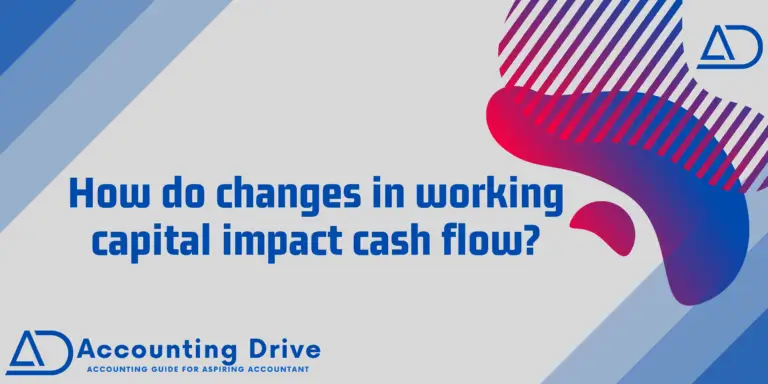It is always tricky to understand the difference between cash flow and working capital. And it looks quite difficult to link cash flow with working capital. Or to understand what changes in working capital impact the cash flow?
Keeping a thorough consideration on it is necessary if you are an accountant or managing your own business. Because small enterprises need to track the business’s financial health more accurately because it is the life and death of their business. Every section of a financial statement impacts one another that’s, how changes in working capital affect a company’s cash flow.
Let’s explore what changes in working capital impact cash flow.

- Working capital and cash flow provide a glance at the company’s operating finances. Working capital gives a snapshot of an entity’s present ability to pay its current debts. While cash flow represents every inflow and every outflow of money over a certain period. You can say that they show a company’s financial details on a micro or macro level.
What is Cash Flow?
In This Article
ToggleLet’s first discuss these two terms, Working Capital and Cash Flow, in detail to make ourselves clear about the differences between them.
Cash flow is linked with the cash flow statement, which is also an important part of a company’s financial statement. Cash Flow is the cash and cash equivalents that come in and out of an entity.
How to Calculate Cash Flow?
Cash Flow Formula
Cash Flow = Cash flow from operating activities +/- Cash flows from investing activities +/-Cash flows from financing activities + Beginning cash flows.
- Positive cash flow shows that the company has enough cash to settle its debts, pay dividends to the shareholders, finance its operations well by paying expenses, and have spare money for future uncertainties.
- Negative cash flow results when operating activities don’t provide sufficient cash to stay liquid. This situation occurred when the company’s money was stuck in account receivable and stock or huge capital expenditure.
What is Working Capital?
Working capital is linked with the balance sheet, a fundamental part of a company’s financial statement. It exhibits the difference between a company’s current assets and current liabilities, it is also known as net working capital. Net working capital is defined as the company’s available money to pay its short-term liabilities.
Get Free access to the AD's working capital cheat sheet
Grab your cheat sheet now by clicking the button !!

How to Calculate Net Working Capital?
Net Working Capital Formula
Net Working Capital = Current Assets – Current Liabilities
- Positive working capital is when an entity has sufficient current assets rather than its current liabilities, which shows that the company can pay its next 12 months due debts. Sometimes, a positive working capital figure is not perfect because it shows that the company that has excessive cash is not making good use of it.
- Negative working capital is when the current liabilities are more than the current assets. It is noticeable that this figure could be temporary when the company has to pay a large amount of cash due to the purchase of products and services from its suppliers. Smart companies manage negative working capital smartly.
Nonetheless, if the working capital remains negative for a long time, it shows that the company is relying on its current liabilities to finance its operations.
Particulars of Working Capital and their Link with Cash Flow
To understand how the working capital’s changes impact cash flow, first, you need to understand the particulars of working capital. Working capital is a part of the operating cash flow; changes in these particulars eventually affect the cash flow.
In a cash flow statement, the operating parts of the working capital’s asset side generally include:
- Accounts receivables
- Stock
- Prepaid expenses
- Other current assets
Increasing in any of these requires the use of cash. If you see a declining trend in current assets, it means cash is being used.
The current liabilities that categorize as operating cash flow are:
- Accounts payable & accrued expenses
- Deferred/unearned revenue
- Taxes payable
- Other current liabilities
Increasing any of these eventually delay the use of cash. If current liabilities are increasing, it shows that less cash is being used. Because the company is rescheduling its payments or getting money in advance (prepaid by the client) before the service is provided.
The “impact” relates to how the cash flow has changed when there is positive and negative fluctuation in working capital.
How do changes in working capital impact cash flow?
You must see and link what could happen to cash flow if a current asset or current liability increases or decreases.
Example: How do Changes in Working Capital Impact Cash Flow?
Here we have elaborated few situations to understand the impact of working capital changes on cash flow.
Situation# 1
- If a transaction increases current assets and current liabilities by the same amount, there will be no change in working capital. But cash flow will increase.
Example: Suppose a company received a certain amount of money as short-term debt. In this case, there must be an increase in the cash flow statement. Working capital would change as its current asset increases and current liability increases by the same amount as a note payable.
Situation# 2
- If a transaction decreases a current asset but has no effect on current liability, there will be a decrease in working capital and cash flow.
Example: If a company has bought a certain fixed asset and the purchase is on cash, cash flow will decrease, as there must be an outflow of the cash. No changes on current liability (let’s assume fixed asset purchased by long-term loan), that eventually decrease working capital and cash flow.
Situation# 3
- If a transaction increases current assets but has no impact on current liability, there will be an increase in working capital and then an increase in cash flow.
If a company sold the fixed asset on cash, it means that there is an inflow of the cash or an increase in accounts receivable without impacting the current liability. In this case, working capital increases increase the cash flow.
Situation# 4
- If a transaction increases account payable and current assets simultaneously by the same amount, there will be no impact on working capital, but cash flow will reduce.
If a company buys inventory in cash, it means there must be an increase in inventory with an upfront cash payment. In this case, cash will reduce while stock will increase. So, there will be no change in working capital, but cash flow will reduce.
Key Points
- Working capital is linked with the balance sheet, whereas Cash flow is linked with the cash flow statement.
- Working capital is the remaining amount after paying all current liabilities, whereas cash flow is the movement of cash in or out of an organization.
- An increase or decrease in working capital may lead toward fluctuations in total cash flow.
- It is important to understand that a massive decrease in working capital may be due to long-term investment, producing good future earnings.
- Positive working capital doesn’t mean that company is managing its cash well; this increase may be due to long-term borrowing, which may not produce sufficient cash flow to pay off debts.
